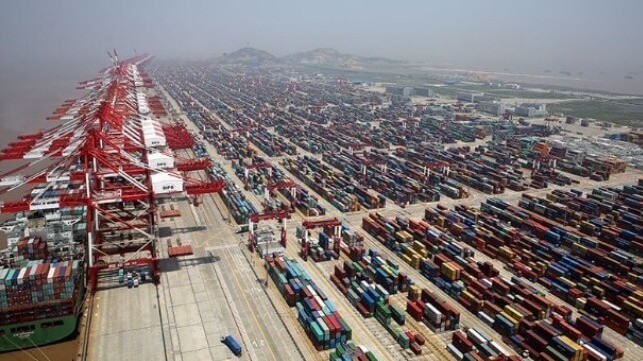Relentless Export Machine: China Doubles its Trade Surplus

[By David Uren]
China’s trade surplus hit an extraordinary $292 billion in the first five months of the year—more than double its pre-pandemic level—and its aggressive pursuit of export markets is likely to become a flashpoint in a slowing world economy.
There is no hint of a concerted Western response to China’s mercantilist strategy, which treats trade surpluses as a manifestation of national power. The World Trade Organization’s rules place no restriction on either the preponderance of state-owned enterprises in the Chinese economy or the subsidies China extends to its private sector, which are fuelling its export boom.
Donald Trump’s administration concluded that the WTO was the problem, not the solution, and sabotaged its ability to adjudicate trade disputes. It unilaterally embarked on a trade war with China, successfully forcing China to sign an agreement in 2020 committing to lift purchases of US goods.
Joe Biden’s administration has been unable to articulate a coherent strategy for managing the Trump legacy in its dealings with China. Although China has increased some US imports, it has fallen far short of its commitments, while China’s exports to the US have surged.
US exports to China in the first four months of this year were $16 billion higher than they were two years ago as the Trump deal took effect, while China’s exports to the US were $73 billion higher.
The Trump deal provided for a punitive escalation of US tariffs on Chinese goods if Beijing failed to fulfil its commitments. The Biden administration toyed with enforcement. Trade representative Katherine Tai said last October that not only would China be required to meet its commitments, but it would also have to reduce its ‘state-centered and non-market trade practices’ which had not been addressed by Trump.
However, the sharp rise of inflation this year has led the Biden administration to foreshadow the removal of tariffs on Chinese goods, some of which are scheduled to expire in July. There have been media suggestions of differences between Tai, who favors retaining tariffs, and Treasury Secretary Janet Yellen, whose over-riding concern with inflation is pressing for their removal. Tai’s promises of enforcement and action on Chinese state subsidies have come to naught.
The European Union’s deficit with China has also risen by 50 percent over the past two years with trade figures for the first four months of this year showing a further blowout. The EU has a number of trade remedies at its fingertips: it is instituting a ‘climate border adjustment’, which allows it to impose taxes on energy-intensive imports that haven’t paid for their carbon emissions and is introducing a scheme to counter the use of trade for economic coercion. The latter would enable the EU to impose retaliatory barriers to trade and investment. Although these measures wouldn’t be legal under the WTO rules, the EU argues that the economic coercion is itself illegal and hence justifies going outside the WTO. There are also moves to strengthen the EU’s human rights restrictions on trade and investment.
At last week’s WTO meeting of trade ministers in Geneva, Tai agreed to a motion requiring members to come up with a reform proposal for the WTO, including its ability to resolve disputes, by the time of the next ministerial meeting, which is likely to be held late next year.
However, the US is yet to present any package of reforms it would find acceptable and there are some significant hurdles. China will never agree to any proposal that allows the subsidies at the heart of its industry policy to be challenged.
A new study by the Center for Strategic and International Studies highlights the massive dimensions of the industrial subsidies that are supporting China’s export machine. It estimates that the Chinese government is spending 1.7 percent of GDP on industry support, mainly through cheap credit to state enterprises and more general direct subsidies. That is more than it spends on defence and is equivalent to over $400 billion at purchasing power exchange rates. It is more than twice as much in dollar terms as the US devotes to industry support and more than twice as much as a share of GDP as the next most aggressive industrial nation, South Korea.
David Uren is a senior fellow at ASPI. This article appears courtesy of ASPI's The Strategist and is reproduced here in an abbreviated form. The original may be found here.
The opinions expressed herein are the author's and not necessarily those of The Maritime Executive.

